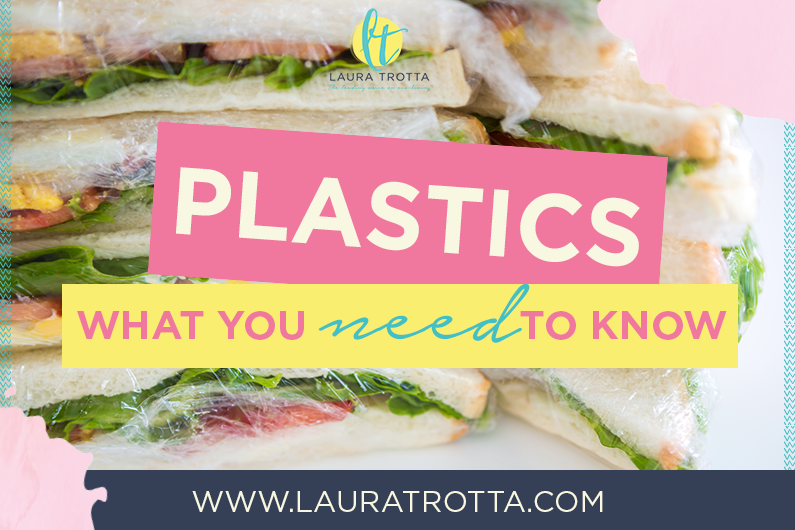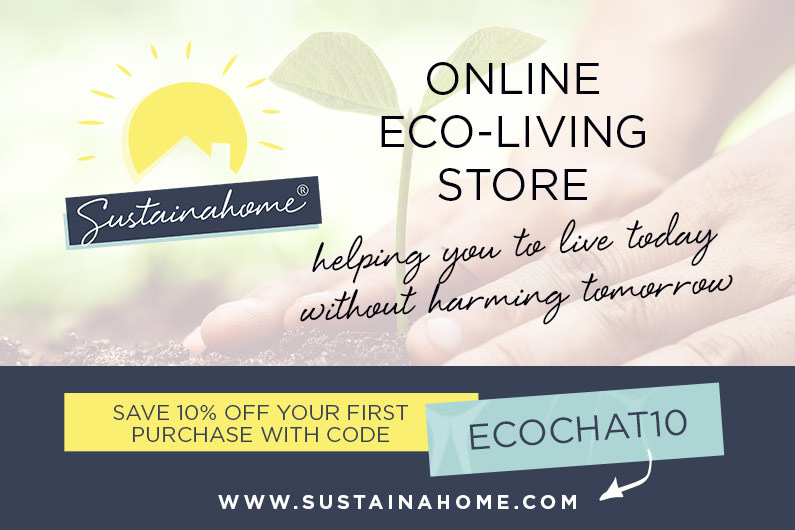Plastics have been linked with obesity, early adolescence, infertility and cancer and take hundreds of years, if ever to break down in our environment. In this post I’ll share why we need to be concerned about plastics and how you can stay healthy in an increasingly plastic world.
Podcast: Play in New Window
What are Plastics?
Plastics are material consisting of a wide range of synthetic or semi-synthetic organics. I’m not talking the certified organic kind here; organic in a chemical context simply refers to it containing carbon.
Typically made from petrochemicals (a non-renewable resource), the many benefits of plastic have contributed to its popularity.
Plastic is cheap and easy to manufacture, versatile, impervious to water and can be re-moulded into solid objects of diverse shapes over and over again (unlike natural products such as wood and horn).
Where are plastics commonly found and used in our homes?
There are so many types of plastic available but here are some of the most common types and uses:
- Polyester (PES) – Fibers, textiles.
- Polyethylene terephthalate (PET) – Carbonated drinks bottles, peanut butter jars, plastic film, microwavable packaging.
- Polyethylene (PE) – Wide range of inexpensive uses including supermarket bags, plastic bottles.
- High-density polyethylene (HDPE) – Detergent bottles, milk jugs, and plastic cases.
- Polyvinyl chloride (PVC) – Plumbing pipes and guttering, shower curtains, window frames, flooring.
- Polyvinylidene chloride (PVDC) (Saran) – Food packaging.
- Low-density polyethylene (LDPE) – Outdoor furniture, siding, floor tiles, shower curtains, clamshell packaging.
- Polypropylene (PP) – Bottle caps, drinking straws, yoghurt containers, appliances, car bumpers, plastic pressure pipe systems.
- Polystyrene (PS) – Packaging foam/”peanuts”, food containers, plastic tableware, disposable cups, plates, cutlery, CD and cassette boxes.
The Environmental Impact of Plastics
One of the things we love about plastics (their durability) is one of the main reasons they’re so detrimental in the environment – and that’s the fact that they persist!!!
Whether it’s plastic bags that are eaten by turtles mistaking them for jellyfish, or microscopic beads of plastic from beauty products contaminating our waterways, our oceans are littered with plastic, and it’s having a massive impact.
One of the problematic properties of plastic is that it’s not biodegradable; it literally lasts forever.
While plastic does not biodegrade, it does photodegrade: UV light from the sun breaks the plastic down into ever-smaller pieces of plastic known as microplastics.
These microplastics continue to photodegrade into smaller and smaller pieces, but they always remain what they are….plastic…. just smaller pieces that are increasingly harder to clean up.
Scientists have reported that over 90% of the plastic polluting our oceans is made up of microplastics smaller than your fingernail. This photodegradation continues right down to the microscopic level, where we can’t even see the individual pieces of plastic with the naked eye. What we do see is a viscous toxic sludge where water should be. Plastic in our oceans has changed from rubbish washing up on deserted beaches to the issue of microplastics changing the chemical composition of our oceans as a whole.
These microplastics act like sponges. They soak up and retain all kinds of toxic chemicals, such as DDT and PCBs. Unable to distinguish their food from microplastics, many marine animals end up dying with bellies so full of plastic that no food can pass through them. They can literally starve to death with full stomachs.
If these marine animals survive to be consumed by humans, the plastic they’ve consumed, and the toxins they’ve absorbed, end up directly in our food chain.
Plastic waste is not just confined to our oceans, our land is full of it too. Where archaeologists in the past have dug up bones, shells and iron tools of past civilisations, future archaeologists will be excavating plastics.
The Human Health Impact of Plastics
Plastics have infiltrated every aspect of our lives and no more than food packaging and storage; around 30% of plastic in western societies is used in food packaging.
Reheating food in plastic trays or containers in microwaves is commonplace, as is plastic wrap – from covering the humble sandwich in a child’s lunchbox to wrapping the organic fresh produce in your local supermarket!!
But are these habits impacting our health?
A 2004 study found that “Food packaging can interact with the packaged foodstuff by diffusion-controlled processes which mainly depend on chemical properties of the Food Contact Material (FCM) and the foodstuff, temperatures at packaging, during heat transport and storage, exposure to UV light, and storage time of the product.” (Arvanitoyannis and Bosnea, 2004)
This interaction can lead to FCM compounds leaching from the packaging to the food, a process known as “migration”.
Food-packaging associated compounds detected in humans include Bisphenol A (BPA), nonylphenol, perfluorinated compounds and phthalates (Muncke, 2009). Statistically significant correlations have been found between increased BPA body burdens and cardiovascular diseases and diabetes (Lang et al, 2008). But, quite possibly, the greatest area of concern lies in plastics containing endocrine disrupting chemicals.
Endocrine Disrupting Chemicals in Plastics
Endocrine disrupting chemicals (EDCs) can be found in everyday items such as plastics bottles and containers, metal cans, detergents, air fresheners, foods, toys and cosmetics. They include chemicals such as polychlorinated biphenyls, pesticides and plasticizers, in particular bisphenol A, or BPA.
They can enter our bodies through absorption (skin), inhalation or ingestion (food) and once in our bodies they can contribute to health problems by mimicking, blocking or otherwise interfering with the body’s natural hormones like oestrogen, androgens and thyroid hormones. Thus, EDCs prevent natural hormones from doing their jobs and they can alter the way cells develop and grow.
Most of us have heard of endocrine disrupting chemicals and know they have the potential to disrupt the endocrine system (that is, the glands that produce hormones, regulate metabolism, growth, development, sexual function, reproduction and mood) but our understanding of what these chemicals are capable of is still pretty slim. You could be forgiven for thinking the extent of their impact is limited to early-onset puberty in our daughters but unfortunately that’s just one worm in the EDC can.
Following from research conducted in 2009, the Endocrine Society released a statement emphasizing the danger of EDCs, and how they have linked EDCs to an increased risk of obesity, diabetes, infertility, hormone-related cancers and neurological problems.
In fact, Human diseases linked to endocrine disrupting chemicals include:
- Cancers of the breast, prostate and testis
- Insulin resistance or metabolic syndrome
- Type 2 diabetes
- Obesity
- Allergies and autoimmune diseases
- Infertility
- Malformations of newborn male genitalia (Muncke, 2009)
Some EDCs have been shown to cross the placental barrier, potentially affecting the human fetus by hormonal disruption at sensitive stage of development which could lead to adult diseases (Fenton, 2006).
Even more disturbing, some EDCs disturb epigenetic imprinting which affects subsequent generations (Anway et al, 2005). This research is the most alarming as it suggests that endocrine disrupting chemicals may have the potential to change our genetic makeup.
How Can We Reduce Our Exposure to Endocrine Disrupting Chemicals?
While improved regulation for chemicals and better safety testing is needed to identify new endocrine disrupting chemicals and ensure they’re kept out of everyday household goods to reduce the risk to the general population, you can get a head start by simply reducing or eliminating products that contain EDCs from your household and making the switch to natural alternatives.
Be it your laundry detergent, cleaning sprays, fabric softener, shampoo, hand cream, kitchen storage containers or air freshener, safer and effective alternatives are out there and it makes total sense to make the change, for your health, our environment, and perhaps even your waistline!
If you’re keen to reduce your family’s exposure to toxins including those found in plastics, check out my FREE Cleaning with Foods Challenge. You can also download your FREE Home Detox Cheat Sheet or pop your name on the waiting list for my popular Home Detox Boot Camp here.
Stay tuned too as next week on the blog/podcast I’ll be sharing Part 2 of my feature on plastics, 19 Ways To Break Up With Plastics in Your Home.
Podcast: Play in new window | Download
- Sustainable Home Design- factors to consider to maximise sustainability - July 28, 2022
- Advantage and Disadvantages of Tiny Houses - May 31, 2022
- How School Strike 4 Climate is Empowering Youth to Fight for Their Future - May 1, 2022



 Laura Trotta is one of Australia’s leading home sustainability experts. She has a Bachelor of Environmental Engineering, a Masters of Science (in Environmental Chemistry) and spent 11 years working as an environmental professional before creating her first online eco business, Sustainababy, in 2009. She has won numerous regional and national awards for her fresh and inspiring take on living an ‘ecoceptional’ life (including most recently winning the Brand South Australia Flinders University Education Award (2015) for the north-west region in SA and silver in the Eco-friendly category of the 2015 Ausmumpreneur Awards). With a regular segment on ABC Radio and with her work featured in publications like Nurture Parenting and My Child Magazine, Laura is an eco thought leader who’s not afraid to challenge the status quo. A passionate believer in addressing the small things to achieve big change, and protecting the planet in practical ways, Laura lives with her husband and two sons in outback South Australia.
Laura Trotta is one of Australia’s leading home sustainability experts. She has a Bachelor of Environmental Engineering, a Masters of Science (in Environmental Chemistry) and spent 11 years working as an environmental professional before creating her first online eco business, Sustainababy, in 2009. She has won numerous regional and national awards for her fresh and inspiring take on living an ‘ecoceptional’ life (including most recently winning the Brand South Australia Flinders University Education Award (2015) for the north-west region in SA and silver in the Eco-friendly category of the 2015 Ausmumpreneur Awards). With a regular segment on ABC Radio and with her work featured in publications like Nurture Parenting and My Child Magazine, Laura is an eco thought leader who’s not afraid to challenge the status quo. A passionate believer in addressing the small things to achieve big change, and protecting the planet in practical ways, Laura lives with her husband and two sons in outback South Australia. 


